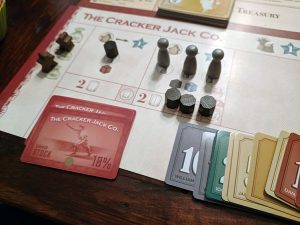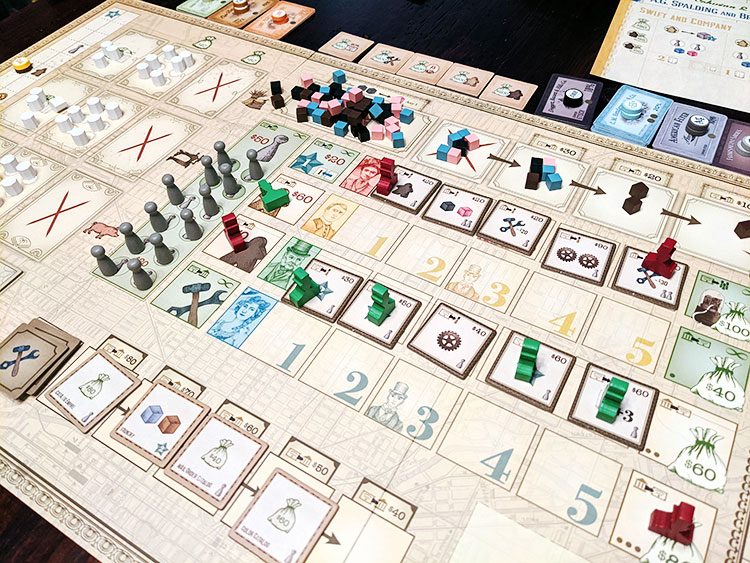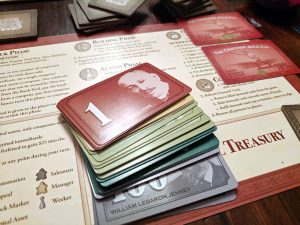 City of Big Shoulders by Raymond Chandler III for Parallel Games and Quined Games has been touted as a gateway game to 18XX. Otherwise known as an 18XX without any of the choo-choo’s. I disagree. City of the Big Shoulders is a great euro-style worker placement, economic, and stock holding game that blends the three genres with complex decision making, variable player powers, and a strong theme. The real question is, can a game that some see as a gateway and others as a pinnacle of average gamer complexity really satisfy players on both sides, or is it a confusing, middling wannabe euro that will go up like the Great Chicago Fire?
City of Big Shoulders by Raymond Chandler III for Parallel Games and Quined Games has been touted as a gateway game to 18XX. Otherwise known as an 18XX without any of the choo-choo’s. I disagree. City of the Big Shoulders is a great euro-style worker placement, economic, and stock holding game that blends the three genres with complex decision making, variable player powers, and a strong theme. The real question is, can a game that some see as a gateway and others as a pinnacle of average gamer complexity really satisfy players on both sides, or is it a confusing, middling wannabe euro that will go up like the Great Chicago Fire?
City of the Big Shoulders is a worker placement, economic, and stock holding game for two to four players that plays well at all player counts. It takes about two to three hours to play.
Gameplay Overview:
City of Big Shoulders pits players against one another as competing Chicagoland entrepreneurs during the five booming decades between the Great Chicago Fire of 1871 and the Great Stock Market Crash of 1929. At the start of the game, players choose one of several fledgling companies to invest in and serve as director. Each turn, players will invest in each other’s companies, start new ones and (in the advanced game) take control of their opponent’s companies all while reaping the capital and revenue rewards of manufacturing and commerce. City of the Big Shoulders is one part resource management/conversion, one part worker placement, and one part stock exchange simulation.

This review includes content from the Burden of Destiny expansion, but it should be noted that outside of component upgrades and additional companies, the game’s ruleset remains unchanged. So, while I will refer to City of the Big Shoulders by name throughout most of this review, everything applies to Burden of Destiny.
The board is divided into several sections with tiles or cubes for each. I’m going to explain a few of the board sections and components to give an idea of game variability and replay value, but City of the Big Shoulders comes with a (great/thorough/detailed) 40-page rule book that is definitely worth the time to read if this piques your interest.
- Demand tiles are randomized at setup and show the available demand for a particular type of good (textile, pork, etc);
- Capital assets can be purchased to add special abilities or bonuses to a company;
- Building spaces are arranged in a row next to each player color and create worker placement action spaces whose cost is (usually) paid to that player by the company worker who uses it or the bank;
- The appeal track determines how desirable a particular stock in a company actually is and the stock track determines how much stock each company is worth;
- Haymarket Square is where companies go to purchase resources (i.e. colored cubes).

Players start the game with a pile of cash, start a single company, and hold the directorship for that company. There are 15 company charters available and they all have unique factory abilities and require unique resources to convert into different goods (which are then sold to demand tiles). Throughout the game, as companies make greater and greater profits, they are able to expand in a few ways. A company can hire additional salesmen to increase the cost of the goods that they sell; they could open additional factories to manufacture more goods to sell; they are able to automate workers with machinery; and they are able to invest in capital assets that provide special abilities or bonuses that can give them a competitive advantage.
The game is divided into five decades (between 1875 and 1925). Each decade has four phases, the stock phase, the action phase, the operating phase, and the cleanup phase. At the end of the game the winner is the player with the most cash after selling off all of their stock for market value. Below is a bit more detail into how these phases actually play out, but if you are familiar with stock simulations, resource conversion, and economic euros, you could probably skip to the next section.
The stock phase is the player phase. Players are playing on behalf of themselves here. Players start companies, buy and sell stock in different companies, and purchase buildings to open up additional worker placement action spaces.
The action phase is where players send out Partners to represent the player’s interests and the interests of the different companies managed by the player. Partners are essentially workers that complete actions from hiring/automating employees for a company to making capital investments in a company to paying extra dividends to stockholders and increasing the stock price. A lot of the game is played in this phase.
The operating phase plays like familiar resource conversion/manufacturing factory simulation euros (think Terraforming Mars). During this phase companies purchase resources from the market; use those resources to produce goods; and sell those goods to demand tiles. Company Directors (i.e. Players) then decide whether they will pay dividends to the players with that revenue. The remaining revenue is then turned into profit and added to the company coffers and the stock is adjusted up or down based on the amount of the dividend pay out. As always, the more the merrier.
Finally, the cleanup phase is where we rinse and set up to repeat. Resources and tiles are replenished on the board and the decade tracker trudges one step forward.

Game Experience:
We had a blast with this one. Having first played it with four players strong and then several times with as few as two (hello, 2020), City of the Big Shoulders has enough game and enough replay value to hit on all cylinders each playthrough. If at first blush it feels too heavy or too brain burning, trust that with enough time in the evening and some coffee or tea in the pot, you will eventually get the hang of it. Forty pages is tough to digest before seeing how it plays out on the table. If you take nothing else from this review, I strongly recommend that if you are giving the game a chance, do not shy away before you give a couple of decades a dry run.

What struck a lot of us at the table is that the combination of worker placement, resource conversion, and stock market simulation dovetailed so seamlessly. This game is big and it is deep in the decisions it forces players to make not only on behalf of themselves but also their companies—which their opponents have a stake in. This balance between player objectives and company growth (that is so often linked to economic simulation/18XX related fare) has not always been palatable at BGQ. While we were mixed on Tesla vs. Edison and the execution therein (no pun intended), City of the Big Shoulders left us all feeling satisfied at the end.
There are a few catch-up mechanics (small ones, but they’re there) that the game kept everyone invested (sorry/not sorry about these puns…) through to their last turn, the very last dividend payout, the very last stock adjustment. And when a winner was finally named, we all started strategizing about how we would play it differently the next time. The game is over 2 hours long and by the end of it, we were already planning to go again.

It is brilliant in execution, brilliant in balance, and brilliant in replay value. While the Burden of Destiny adds component upgrades and a handful of companies, those companies are well worth the price of admission. (I was reprimanded for failing to disclose that Oscar Mayer is only available in Burden of Desiny, don’t make the same mistake I made—some people care about that sort of thing).
That said, each company, whether in the base game or in Burden of Desiny, is fun to play in its own right. They benefit from different Capital Investments and command different price points for goods. Half of the game is essentially focused on how these differences in companies can be maximized based on the unique requirements and production rates/values of each good they produce. Several companies will overlap in the goods that are produced and drive competition on the demand tiles. Ultimately if the competition is healthy throughout the game, the late game could see goods sell for half value simply because there is no demand for them. The variability in companies is highlighted here and drives company survival and player appetite for multiple endeavors.
Final Thoughts:
For all of its weight as a medium-heavy game, City of the Big Shoulders has a way of presenting the material so as to make it as palatable and as easy to digest as possible. Four players make for an epic industrial match-up, with far less tabletop industrial “reconnaissance” than at fewer player counts. At three and four players, the game is much more focused on the stock market and share buying, selling, and tanking. While at two players it is a race to produce and satisfy as much demand as possible.

I greatly appreciate that although there are transition challenges with new players that are stepping-up into this style of game for the first time, by mid-game most folks were into the rhythm of it.
To call this a gateway game to 18XX is to give City of the Big Shoulders short shrift. The variable company special abilities and the sheer amount of game packed into the box and the rulebook allow City of the Big Shoulders to stand on its own. The new-to-18XX hang-ups of mixing player money with company money can be found here aplenty as well as the mental leap of playing as the entreprenuer/lead investor and representing a company rather than playing as the company can be a challenge for some.
Inevitably with newer players, there is the point in the last two decades where they realize that although, say, they are leading the charge of Oscar Mayer as the stock is going gangbusters, they will never be able to transition those profits from the company to their own wallets or that they have now all together priced themselves out of additional stock for all of that work they put in it.
Although fans of 18XX will be familiar with the structure of the game, it doesn’t fit the mold of “gateway game” by any stretch of the imagination and is worth a look by Euro lovers and 18XXers alike. We loved it, I love it, and I look forward to playing it again.
Final Score: 4.5 Stars – It isn’t often for me that a Kickstarter becomes an “instant classic,” but here we are in the City of the Big Shoulders.
 Hits:
Hits:
• Tremendous replay value between variable player powers and randomized game set-up.
• Good for players looking to take a deeper dive into economic or stockholding games.
• Balances worker placement, resource conversion, and stock holding gameplay well.
Misses:
• The rulebook is deep and detailed but appropriate for the size of the game.
• Definitely requires a dry run for the first playthrough
LC’s Historical Context Corner: Why Chicago? Why focus a game on the mercantile and goods exchanges between 1875 and 1925 in Chicago? More specifically, what led to Chicago being the place for such trading in goods and futures pre-Civil War?
Chicago became the center of the United States of American after what historians refer to as the Transportation Revolution that started around 1815 and picked up steam through to the pre-Civil War 1860s. Prior to this revolution, the cost of transporting goods inland 30 miles from a port was equal to the cost of crossing the Atlantic. Likewise pre-1815, the most cost effective way of moving freight from, let’s say, Cincinnati to New York for export was down the Ohio and Mississippi Rivers to New Orleans and then by sailing-ship along the coast. Beyond the explicitly transportation related costs associated with this travel, goods would have to be hauled from throughout the midwest and laboriously moved overland with all the trials and tribulations of product loss and degradation due to travel that comes with. If you have played Capstone’s The Ruhr or its fraternal twin The Ohio 1811-1861, you are familiar with the transportation losses those simulate.
During the Transportation Revolution, the economic landscape literally changed when governments (local, state, and federal) and private companies financed the construction of unrutted all weather roads, the Erie Canal connecting Albany to Buffalo (and thus NYC to Chicago), and the increase from 9,000 to 30,000 miles of railroad track. Transportation costs alone were reduced immensely from 30 cents/ton/mile in 1815 to 15 cents; a rate adjusted for inflation (in 2020 money) is the equivalent of $5.00/ton/mile. In actuality, according to the 2020 Congressional Budget Office, 2020 overland travel is 15 cents/ton/mile and rail travel is 5 cents/ton/mile. I’ll let you do the math on that one.
So, because the ease of goods transport was improved tremendously, rail from all over the breadbasket of the US was able to meet at the nexus of railroad and canal that was ultimately Chicago. After the 1871 Great Chicago Fire hit a reset on the city (much like the 1666 Fire of London and Martin Wallace’s London or the 1755 Great Lisbon Earthquake, Tsunamis, and fires and Vital Lacerda’s Lisboa) surviving citizens were left with an open landscape for a city and economy to rebuild. For future entrepreneurs and hearty workers “under the smoke, dust all over his mouth, laughing with white teeth,” this sounds like a good place to start a game as well.
For additional reading and information, you can start by checking out the below materials at your local library. At the very least, if you are reading this in or near the hellscape that has been 2020, please check out the poem “Chicago” by Carl Sandburg:
- Rogers, Taylor. The Transportation Revolution, 1851-1860. New York, Rinehart, 1951.
- McPherson, James. Battle Cry of Freedom: the Civil War Era. New York, Oxford University Press, 1988.
- Sandburg, Carl. “Chicago.” Poetry. Poetry Foundation, 1914.























Nice review! This is one of my most played games in the last year. It’s very good once you get a fair understanding of how it all works.
Unfortunately it’s currently out of print but keep an eye on Kickstarter. Raymond at Parallel Games is said to be in the planning for a reprint campaign. In the meantime, it’s available for online play at boardgamearena.com.